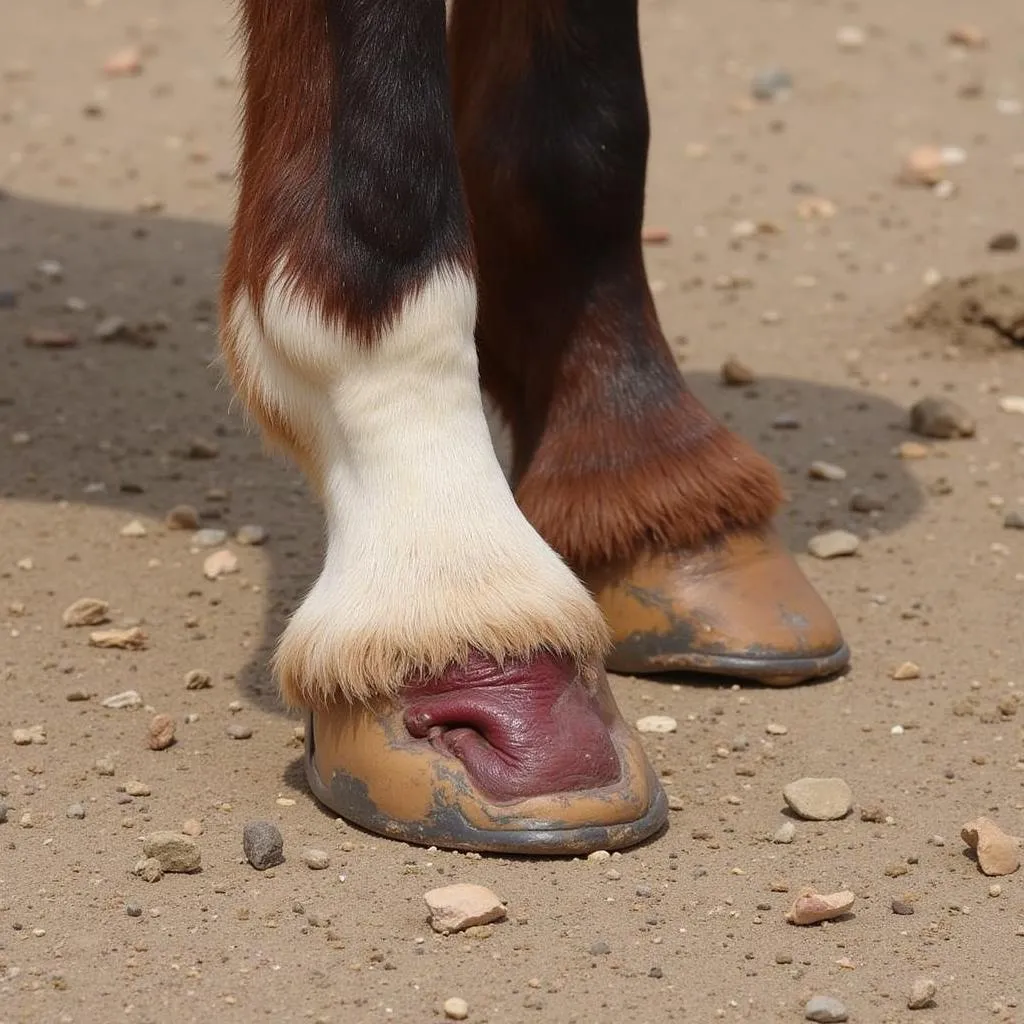Collateral ligament injuries are a common issue that affects horses. This injury, specifically affecting the hoof, can cause lameness and discomfort for your equine companion. In this article, we delve into the causes, symptoms, diagnosis, and treatment options for collateral ligament injuries in horses.
Understanding Collateral Ligaments in the Horse’s Hoof
The collateral ligaments play a crucial role in stabilizing the horse’s hoof. Located on either side of the hoof, they connect the pastern bone to the coffin bone, helping to maintain proper alignment and support. These ligaments are essential for the horse’s ability to walk, trot, and gallop without experiencing instability or pain.
What Causes a Collateral Ligament Injury?
Several factors can contribute to a collateral ligament injury in horses:
- Overexertion: Pushing a horse too hard during training or competition can strain the ligaments, leading to injury.
- Trauma: Accidents, such as a sudden slip or a kick from another horse, can damage the collateral ligaments.
- Conformation: Some horses have a conformation that predisposes them to collateral ligament injuries, such as a long pastern or a weak hoof wall.
- Poor Hoof Care: Neglecting proper hoof care, such as trimming and shoeing, can increase the risk of collateral ligament injuries.
Recognizing the Signs of a Collateral Ligament Injury
If your horse is experiencing a collateral ligament injury, you may notice several symptoms:
- Lameness: This is the most common symptom. The horse may limp, have a short stride, or refuse to move weight on the affected leg.
- Swelling: The area around the injured ligament may be swollen, warm, and painful to the touch.
- Heat: The injured area may feel hotter than the surrounding tissue.
- Pain: The horse may be sensitive to pressure or movement around the injured area.
Diagnosing a Collateral Ligament Injury
A veterinarian can diagnose a collateral ligament injury by examining your horse, evaluating its gait, and performing several tests:
- Physical Examination: The veterinarian will examine the horse’s hooves, legs, and body for signs of injury and lameness.
- Palpation: The veterinarian will feel the ligaments for any signs of tenderness, swelling, or heat.
- Radiographs (X-rays): X-rays can help identify any bone damage or fractures that may be contributing to the injury.
- Ultrasound: Ultrasound imaging allows the veterinarian to visualize the ligaments and surrounding soft tissues, helping to identify tears or other injuries.
Treatment Options for Collateral Ligament Injuries
The treatment plan for a collateral ligament injury will depend on the severity of the injury.
- Rest: Restricting the horse’s movement is essential to allow the ligaments to heal. This can involve stable confinement, hand walking, or turnout in a small paddock.
- Cold Therapy: Applying ice packs to the injured area helps to reduce swelling and inflammation.
- Anti-Inflammatory Medications: Nonsteroidal anti-inflammatory drugs (NSAIDs) can be used to reduce pain and inflammation.
- Support Bandages: Bandaging the injured area can provide support and reduce stress on the ligaments.
- Shoe Modification: Adjusting the horse’s shoeing can help to distribute weight more evenly and reduce strain on the injured ligament.
- Surgery: In severe cases of collateral ligament injury, surgery may be required to repair the torn ligament or stabilize the joint.
Rehabilitation and Recovery
After treatment, it is crucial to gradually rehabilitate the horse to help it regain its strength and mobility. This involves a controlled program of exercise and stretching under the guidance of a veterinarian.
“A horse that is recovering from a collateral ligament injury needs a gradual and patient approach to rehabilitation. Rushing the process can lead to reinjury. It’s important to work closely with a veterinarian and follow their recommendations for exercise progression.” – Dr. Emily Carter, DVM
Prevention of Collateral Ligament Injuries
While collateral ligament injuries are not always preventable, you can take steps to reduce the risk of injury in your horse:
- Proper Hoof Care: Regularly trim and shoe your horse’s hooves to maintain proper hoof balance and reduce stress on the ligaments.
- Gradual Training: Increase your horse’s training intensity gradually, avoiding overexertion or sudden changes in workload.
- Adequate Conditioning: Ensure your horse is well-conditioned before starting any strenuous activity.
- Safe Environment: Provide a safe environment for your horse, free from hazards that could cause injury.
Frequently Asked Questions
Q: How long does it take for a collateral ligament injury to heal?
A: The healing time for a collateral ligament injury depends on the severity of the injury. Minor injuries may take a few weeks to heal, while severe injuries can take several months.
Q: Can a horse with a collateral ligament injury return to athletic performance?
A: Yes, many horses with collateral ligament injuries can return to athletic performance with proper rehabilitation and care. However, the horse’s ability to return to its previous level of activity will depend on the severity of the injury and the horse’s individual factors.
Q: What is the prognosis for a horse with a collateral ligament injury?
A: The prognosis for a horse with a collateral ligament injury varies depending on the severity of the injury, the horse’s overall health, and the effectiveness of treatment. Some horses make a full recovery, while others may have long-term lameness or limitations in their athletic performance.
Conclusion
Collateral ligament injuries in horses can cause pain and lameness, but with proper treatment and rehabilitation, many horses can return to their previous level of activity. If you suspect your horse may have a collateral ligament injury, it is essential to contact a veterinarian for a diagnosis and treatment plan. Early intervention and careful management can significantly improve the horse’s chances of a successful recovery.
 Collateral ligament injury affecting the hoof in a horse
Collateral ligament injury affecting the hoof in a horse
Please remember: This article is for informational purposes only. Always consult a veterinarian for professional advice regarding your horse’s health and any potential injuries.